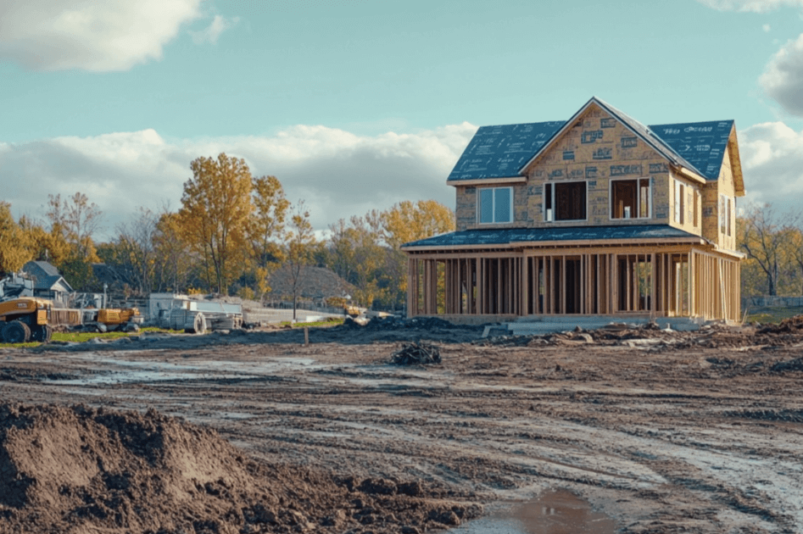
Joists and beams are two terms you’re bound to hear when doing any kind of significant home construction to remodel. These structural elements work hand-in-hand to provide the support needed to handle the weight of a roof, floor, or even a deck. Without them, you wouldn’t have the stability needed to safely walk or place anything on a surface. Roofers and builders know that if either is undersized or incorrectly installed, it can lead to structural failure, which is why understanding how they work is so crucial in construction.
These two components may seem like just another part of the frame, but they play a huge role in ensuring a building stands strong for years. So whether you’re a homeowner planning renovations or a contractor working on new builds, knowing the difference between joists and beams can save a lot of headaches down the line.
What is a Joist?
Joists are long, horizontal supports that run across open spaces, primarily used in floors and ceilings. Think of joists like the skeleton of a structure—they provide the framework that holds everything together. Typically made from wood, engineered lumber, or steel, joists are placed parallel to each other and spaced at regular intervals. Their job is to distribute the load evenly across the structure, making sure the floor or roof remains solid and doesn’t sag.
In most homes, joists are used to support the floors you walk on or the ceilings above your head. They carry the weight from above (like furniture, appliances, or even the roof) and transfer it to the beams or walls. The size of the joist depends on the span they need to cover and the weight they’re expected to hold, with larger spans requiring deeper or stronger joists. In simpler terms, joists are the workhorses that keep your floors flat and your roof secure.
What is a Beam?
Beams are the heavy lifters in any structural framework. Unlike joists, which are smaller and spaced more closely together, beams are much larger and span longer distances. Beams provide primary support by carrying the load from joists or other structural elements and transferring that weight down to the foundation of the building. You’ll often see beams used in roofs, walls, and floors, where they support everything from heavy roof trusses to multiple levels of flooring.
Beams can be made of wood, steel, or reinforced concrete, depending on the building’s design and the weight they need to support. Because beams bear so much weight, they’re typically placed perpendicular to joists and spaced further apart. While joists handle the smaller loads, beams take on the big stuff—like the walls, the roof, and the overall structure. Without beams, the entire framework would lack the central support needed to stay standing.
Key Differences Between Joists and Beams
The main difference between joists and beams comes down to the roles they play in distributing weight. Joists spread out the load across a wide area, making sure the floor or roof doesn’t buckle under pressure. Beams, on the other hand, support the joists themselves and direct all that weight to the foundation or load-bearing walls.
- Load Distribution: Beams carry the heavy load from above, while joists distribute the weight evenly across smaller sections. It’s a division of labor that keeps everything stable.
- Positioning and Spacing: Joists are placed closely together—typically 16 to 24 inches apart—while beams are spaced much further apart, often supporting multiple joists at once. This positioning allows beams to take on more weight, while joists handle the smaller loads.
- Size and Strength: Beams are significantly larger than joists because they need to support much heavier loads. Where joists might measure 2×8 or 2×10, beams can be as large as 6×12 or even bigger, depending on the structure.
Think of beams as the backbone of the structure, while joists are like the ribs. The beams provide the main support, and the joists help distribute weight evenly, making sure everything holds steady.
How Joists and Beams Matter to Homeowners
For homeowners, understanding the difference between joists and beams can make a big impact on your decision-making during renovations, repairs, or inspections. If you’ve ever noticed creaky floors, sagging ceilings, or uneven surfaces, it’s often due to an issue with either the joists or the beams. Knowing how these two components work can help you identify potential problems before they become costly repairs.
For example, if you’re adding an extension or remodeling your attic, you need to know whether the current joists and beams can handle the extra load. This is where professional advice becomes more important, but having some knowledge yourself means you’re better equipped to ask the right questions.
How Joists and Beams Work Together
Joists and beams are like a team. They each play different roles, but together, they ensure your house stays solid and stable. The joists rest on top of the beams, distributing weight across the entire span of a roof, ceiling, or floor. The beams, in turn, bear the load from the joists and transfer that weight to the vertical supports, like load-bearing walls or columns, and eventually down to the foundation.
Without beams, joists wouldn’t have the support they need, and without joists, the weight wouldn’t be evenly distributed. This relationship is crucial for preventing issues like sagging, cracking, or even structural collapse. It’s especially important in homes with open floor plans or large, unsupported spans, where beams and joists must work together to carry the load of the roof and floors without compromising safety.
A common scenario in roofing is when beams and joists need to support a heavy roof material, like clay tiles or slate. In this case, the spacing, size, and material of both the joists and beams need to be carefully calculated to ensure the roof doesn’t fail under the extra weight. Every structure depends on these two elements working together to provide a safe and functional home.
Mistakes to Avoid
Even small mistakes with joists and beams can lead to big structural problems later. Here are some common errors homeowners and contractors should watch out for:
- Misalignment: Joists must be perfectly aligned with the beams to distribute weight correctly. If they’re off by even a few inches, it can lead to sagging or uneven surfaces. Always make sure joists are spaced and aligned correctly with the beam layout.
- Incorrect Spacing: Joists and beams have specific spacing requirements. Installing joists too far apart weakens the floor or ceiling, making it more prone to flexing and damage. Beams that are spaced too far apart won’t properly support the joists. Follow manufacturer guidelines or building codes for proper spacing.
- Using the Wrong Material: Not all wood or steel is created equal. Using undersized or weaker material than necessary can result in structural failure. Always choose joists and beams that are rated to carry the expected load.
- Failing to Account for Load: A common mistake is underestimating the load that joists and beams need to support. Whether it’s a heavy roof, a new second floor, or a large deck, the load must be calculated properly. Under-engineering these components can lead to dangerous sagging or even collapse over time.
To avoid these mistakes, it’s always best to consult a structural engineer or roofing professional who can ensure the correct materials, spacing, and alignment are used. Taking shortcuts with joists and beams might save time or money upfront, but it’ll cost you far more in repairs later.
Measure Twice, Cut Once
Joists and beams might not be the most glamorous part of construction, but they’re among the most important. If you’re planning any work that involves joists or beams, or you’re noticing signs of structural issues, it’s always smart to get an expert’s opinion. A quick inspection can prevent costly repairs down the road and ensure your home is in top shape. Don’t hesitate to reach out to Presidio Roofing so we can guide you through the process and make sure your structure is safe and sound.





